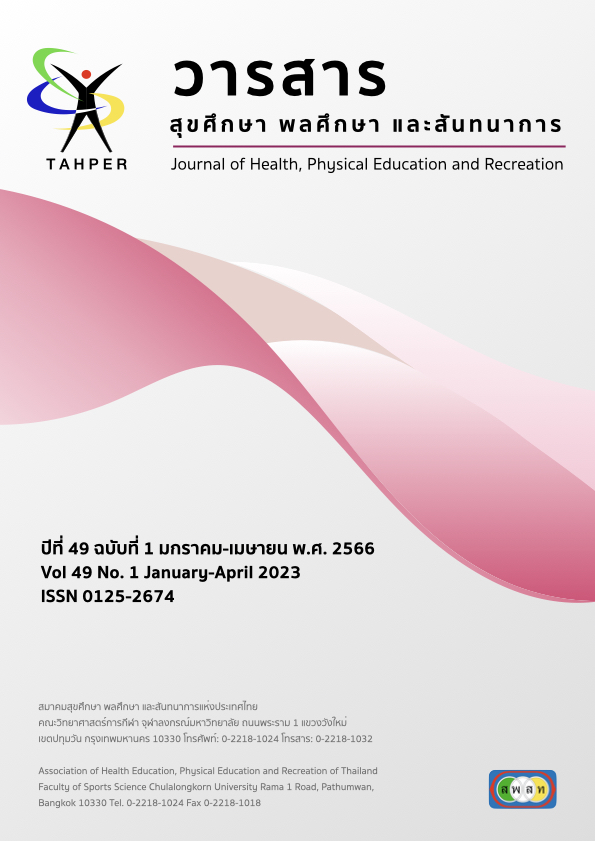State Anxiety of Shooting Attending the 43rd Institute of Physical Education Games of Thailand
Main Article Content
Abstract
This research aims to study and compare degrees of situated anxiety between male and female shooters who participated in the 43rd competition arranged by Institute of Physical Education of Thailand. 102 shooters who participated in the 43rd competition arranged by Institute of Physical Education of Thailand were selected as a population by purposive sampling method. Among these participants, 56 were male while another 46 were female. A tool that used to collect data was Revised Competitive Sport Anxiety Inventory – 2 (CSAI – 2R) (Cox; Martens; & Russell. 2003) with validity value of 0.75. This included with physical anxiety, mental anxiety, and self confidence. Data were analyzed by comparing differences of mean (μ) and standard deviation (σ) of situated anxiety between male and female shooters for three day and before the competition in the qualifying round before an hour is day and prior to the final round. T-Test Independent was a statistic that used in order to examine differences at a statistical significance of .05 The research found it that:
1. Situated anxiety prior to the competition in the qualifying round for a three days found that both male and female shooters had physical anxiety, mental anxiety and
- Situated anxiety prior to the competition in the qualifying round for a day found that both male and female shooters had physical anxiety, mental anxiety and self confidence in moderate level and found no statistical significance.
- Situated anxiety prior to the final round for an hour found that both male and female shooters had physical anxiety in moderate level with no statistical significance, had self confidence in high level with no statistical significance. Mental anxiety of male and female shooters found to be high and different at a statistical significance of .05
Article Details

This work is licensed under a Creative Commons Attribution-NonCommercial-NoDerivatives 4.0 International License.
Critical thinking in journals is the right of the author. The Association of Health Education, Physical Education and Recreation of Thailand is not always required, to create diversity in ideas and creativity.
ความคิด ข้อวิพากษ์ในวารสารเป้นสิทธิของผู้เขียน สมาคมสุขศึกษา พลศึกษา และสันทนาการแห่งประเทศไทยไม่จำเป็นต้องเห็นชอบด้วยเสมอไป เพื่อให้เกิดความหลากหลายในความคิดและความสร้างสรรค์
References
นภพร ทัศนัยนา .(2536). ปัจจัยคัดสรรที่มีผลต่อความสำเร็จในการแข่งขันกีฬา. วิทยานิพนธ์ ครุศาสตรดุษฎีบัณฑิต, สาขาพลศึกษา บัณฑิตวิทยาลัย, จุฬาลงกรณ์มหาวิทยาลัย.
ปราณี อยู่ศิริ. 2542. ความสัมพันธ์ระหว่างความวิตกกังวลอันเป็นลักษณะนิสัยและเจตคติที่เกี่ยวข้องกับ งานและตนเองที่มีต่อการเล่นกีฬาของนักกีฬามหาวิทยาลัยศรีนรินทรวิโรฒ. ปริญญาการศึกษา มหาบัณฑิต สาขาพลศึกษา, มหาวิทยาลัยศรีนครินทรวิโรฒ.
พิชิต เมืองนาโพธิ์. (2534). เอกสารประกอบการสอนจิตวิทยาการกีฬา. กรุงเทพฯ: คณะพลศึกษา มหาวิทยาลัยศรีนครินทรวิโรฒ.
สมบัติ กาญจนกิจ. บทบาทและรูปแบบสันทนาการปัจจุบันสู่อนาคต. วารสารสุขศึกษาพลศึกษาและสันทนาการ. เมษายน – มิถุนายน ; 15 (2), 2532.
สมบัติ กาญจนกิจและ สมหญิง จันทรุไทย. จิตวิทยาการกีฬา แนวคิด ทฤษฎี สู่การปฏิบัติ.กรุงเทพมหานคร: สำนักพิมพ์แห่งจุฬาลงกรณ์มหาวิทยาลัย, 2542.
สืบสาย บุญวีรบุตร. จิตวิทยาการกีฬา. ชลบุรี: ชลบุรีการพิมพ์, 2541.
สุพัชรินทร์ กลมเกลี้ยง. ความวิตกกังวลและความเครียดทางการกีฬา. วารสารศึกษาศาสตร์ปริทัศน์ ปีที่ 22 ฉบับที่ 3 หน้า 65-78, 2550.
สุพัชรินทร์ ปานอุทัย. ความเข้มและทิศทางของความวิตกกังวลของนักกีฬาก่อนการแข่งขัน. วารสารวิทยาสารกำแพงแสน ปีที่ 8 ฉบับที่ 1 หน้า 31-32 , 2553.
Abenza, L., et al. (2009). Relationship Between The Anxiety and Prformance of a Basketball Team During Competition. Revista de Psicología del Deporte 2009, Vol.18 –suppl,. pp. 409-413 – ISSN: 1132-239X.
Bali . Psychological Factors Affecting Sports Performance. International Journal of Physical Education, Sports and Health 2015; 1(6): 92-95.
BUTT, Bei HU, Khurram SHAFI, Babur Hayat MALIK. Study of Organizational Environment, Incentives and Promotion and its Effect on Employee`s Motivation.
Cox, R. H. (2007). Sport Psychology, concepts and applications (6th ed.). New York: McGrawHill.
Marten use of habitat in a commercially clear-cut forest. J. Wildl. Manage. 46(1): 175-182.
Yuri L. Hanin. (1970). Emotions in Sport: Current Issues and Perspectives. KIHU-Research Institute for Olympic Sports, Finland.
Klavoras, P. (1977). An attempt to drive inverted – U curve based on the relationship between anxiety and athletic performance.
D.M. Landers and R.W. Christina (eds.). Psychology of motor behavior and sport. Champaign, IL: Human Kinetics Publishers.
Martens, R. and D.L. Gill. (1976). “State Anxiety among Successful Competitors Who Differ in Competitive Trait Anxiety”. Research Quarterly, 47 : 698 – 708.
---------. (1977). Sport Competition Anxiety Test. Champaign,IL : Human Kineticy.
--------- (1987). “Science, Knowledge and Sport Psychology”. Sport Psychologist, 1: 29 – 55.
Parnabas, et al. (2013). The Relationship between Cognitive and Somatic Anxiety on Performance of Student-Athletes of Universiti Malaysia Perlis (UNIMAP). http://www.hrpub.org
Rice, A. J. (2016). Social class and masculinity. In Y. J. Wong, S. R. Wester (Eds.), APA handbook of men and masculinities (pp. 1344). Washington.
Rainay, D. W. and Cunningham it. (1988). Consentitive Trait Anxiety in Male and Female Collage Athletes. Research Qaurterly Foe Exercise and Sport.


